Story at a glance:
- Stainless steel is 100% recyclable, making it a sustainable building option.
- Stainless steel can weigh one-third to one-fourth the weight of concrete.
- Kitchen countertops made of stainless steel require less upkeep than those made of stone or marble.
Stainless steel is a timeless classic for a reason. It’s resistant to corrosion, easy to clean, and complements its surrounding materials. The ways to use stainless steel in construction are seemingly endless.
From kitchen countertops to pools to acoustical decking, stainless steel is a versatile material. Here are just a few of the ways to use stainless steel in construction.
1. Drainage Systems

Stainless steel drainage offers a system that requires minimal maintenance. Photo courtesy of ACO, Inc.
Architects may turn to drainage systems made of stainless steel for their hygienic properties, ease of installation, and recyclability.
ACO, Inc. builds and installs food and beverage and floor drains designed to last an excess of 50 years, according to Gert Laumann, leader of building drainage at ACO. “Not only do stainless steel pipes provide a nontoxic, smooth surface that can be easily cleaned and sterilized, but they also have no degradation,” Laumann wrote in a previous article for gb&d. “They have a long lifespan with minimal maintenance and are also corrosion-resistant.”
The process to install ACO’s stainless steel pipes and drainage is about 40% faster compared to cast iron pipe work, according to Laumann. Not only does this save time, but it reduces waste, too.
Plus, stainless steel is 100% recyclable, and ACO purposefully uses no paint or coatings to allow for easy repurposing and recycling.
2. Pools

One of The Cosmopolitan’s rooftop pools in Las Vegas includes custom water features. Photo courtesy of Bradford Pools
The durability, cleanliness, and sustainability of stainless steel make it a top choice for pools today—not to mention it’s easy to install when compared to many other traditional materials.
The sheer difference in weight between stainless steel and concrete makes stainless steel an advantageous option for pool construction. A stainless steel vessel can weigh one-third to one-fourth the weight of a concrete vessel. According to Michael Sage, the vice president of sales and marketing for Bradford Products, the comparatively lightness of steel can save both money and time when it comes to installation.
Stainless steel’s naturally dense, nonporous surface is also ideal for limiting harmful bacteria, and it can withstand frequent, rigorous cleaning.
Bradford Pools incorporates more than 60% post-consumer recycled content in its pools, and the stainless steel is fully recyclable at the end of the pool vessel’s life.
3. Cable Railing

Cable railing fuses nature with the modern aesthetic, perfect for a farmhouse look. Photo courtesy of Key-Link Fencing & Railing
Cable railing can be a subtle attraction to any outdoor or indoor space by offering a sustainable yet sleek alternative to traditional railing styles.
Cable railing replaces traditional balusters with stainless steel cable, giving railings a sleek and modern aesthetic. The railing can run horizontally through posts or vertically between the top and bottom rails.
Being made of aluminum and steel—both of which are 100% recyclable—makes cable railing inherently sustainable, according to Jeremiah Hershberger, product manager for Key-Link Fencing & Railing.
4. Kitchen Countertops

Custom Metal Home’s stainless steel countertops are among their most durable options. Photo courtesy of Custom Metal Home
While kitchen countertops have long been dominated by marble and quartz, metal is making a comeback.
Stainless steel is perfect for anyone looking for an easy to clean, durable kitchen countertop, Bill Lambropoulos, cofounder of Custom Metal Home, previously told gb&d.
“Stainless steel isn’t just for show,” Lambropoulos said. “You can throw hot pans and dishes on there without having to be careful. It’s a very hard, strong, hygienic, rust-resistant material, and that’s why restaurants typically use it.”
Unlike stone or marble, stainless steel requires very little upkeep; it doesn’t need to be polished and is subject to only minimal wear and tear. “It will get some weather marks and it’s not always going to look like it did on day one, but it ages very well.”
5. In Metal Roofs

Stainless steel hardware is used to stabilize metal roofs. Photo courtesy of Drexel Metals
Metal roofs are soaring in popularity as the long-term benefits of them become clear. “Our business has grown double digits every year for the last eight years,” Ken McLauchlan, director of sales for Drexel Metals, told gb&d in a previous interview.
You can expect a metal roof to last at least two to three times longer than a regular roof. Generally speaking, metal roofs may last 40 to 60 years or even longer, whereas roofs made of asphalt last for about 20 years, according to an NAHB study. While the upfront cost may be more, you’ll save in the long run, as you won’t be replacing your roof three, four, or even five times.
Asphalt roofs are made of oil impregnated paper or fiberglass, leading them to deteriorate as soon as exposed to the elements. But metal roofs never decompose.
And while the metal of the roof itself is sturdy, just as important is the related stainless steel hardware that holds Drexel Metals’ roofs in place. “The big issue in our industry is making sure the attachment doesn’t void the warranty,” McLauchlan said. “The engineering is a huge part—the attachment and how it’s done so it’s not sacrificial to the roof is key.”
6. Shower Drains

QM Drain offers sleek square and linear drains so bathroom design doesn’t suffer. Photo Courtesy of QM Drain
QM Drain is doing away with boring, clogged-up circular drains. The shower drain company produces square and linear drains for people seeking cleanliness and style.
According to Karina Bernoti, the company’s drains are 100% recyclable and do not release any harmful chemicals. The marine-grade stainless steel 316 is corrosion-resistant, so it holds up against extreme moisture and resists abrasive household cleaners.
“People want beauty. Things that were once ugly people are more design-oriented about. They want good quality that’s fashionable, and at a good price,” Bernoti previously said to gb&d.
7. Exposed Steel

Exposed steel allows natural light to pass through in the Germantown Friends School’s fieldhouse project by Bohlin Cywinski Jackson. Photo by Peter Aaron
Architecturally exposed structural steel has been gaining popularity in recent years, according to experts like Mark Thimons, vice president of sustainability for the Steel Market Development Institute (SMDI).
When Thimons travels, he often finds himself looking out the window or up at the sky at the structures that tower overhead. “If you look at some of the new steel buildings being built—structural steel or cold-formed steel—there are some really interesting things being done. It can be an exciting material to design with—you can do pretty much anything with it.”
Take, for instance, a fieldhouse project Bohlin Cywinski Jackson completed for the Germantown Friends School in Philadelphia, where the entire steel framing system is exposed to view. The structural angles of stainless steel panels diffused light to brighten the space naturally.
“To us it was really important that we not just resort to roller shades that would not survive in a gymnasium environment,” Tom Kirk, principal for Bohlin Cywinski Jackson, previously told gb&d. It was also an opportunity to ask, “How do you let in daylight but shield the glare that is detrimental to a teaching environment?” Kirk said steel lets you do all that and more, as it also tells a story—where is the sun, and what is your orientation within this environment? Why are these repetitive frames set to that specific angle?
8. Restroom Accessories
The first consideration when constructing a bathroom is its function and hygiene. But secondly, such an intimate space needs to feel welcoming as well as clean. Stainless steel reflects cleanliness and timelessness design.
Bobrick’s Class A executive office restroom outlines a bathroom design that is classy and clean. Among design components, Bobrick includes automatic faucets and soap dispensers, a paper towel dispenser, hand dryer—all made of stainless steel.
9. Acoustics

New Millennium’s steel decking brings a clean lineal plank ceiling aesthetic. In addition to acoustical control, the system opens the way to column-free spaces that are optimal for flexible-use classroom environments. Photo courtesy of Architectural Photography
Acoustical steel decking is a great option for quieting large open spaces like classrooms, auditoriums, or sporting arenas.
Exposed steel decks can not only save money by avoiding lay-in ceiling tiles, but they are also flexible and sustainable. The steel building company New Millennium Building Systems maximizes efficiency through their long-span acoustical steel deck—the Versa-Dek®.
New Millennium’s steel decks are long-span, allowing for fewer structural members to be required, leading to fewer materials, less fabrication, and less waste. Steel is also North America’s most recycled material, and steel decking has post-consumer recycled content that can exceed 70%.




